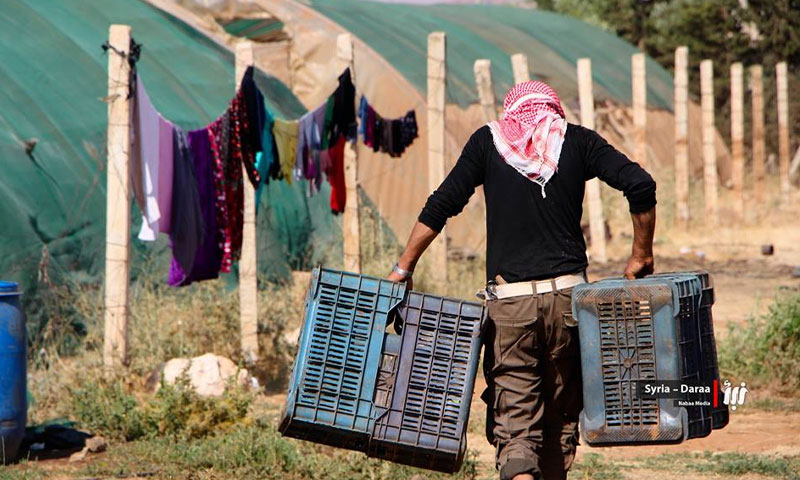Through the first of its kind system in Syria, the Syrian regime controls an intersection that leads to the opposition-held areas in Daraa in Southern Syria, through which it is making millions due to “internal taxation.”
Assad’s forces, since July 2017, resorted to imposing royalties at their checkpoint located at the intersection connecting the towns of Da’el and western al-Ghariyah held by the opposition factions, as well as Khirbet Ghazaleh under the Syrian regime’s control. The returns gained at the checkpoint are about one billion and 120 million Syrian pounds (2.6 million dollars) in one month only, as an informed source told Enab Baladi.
This intersection is one of the strategic roads connecting between the two parties’ strongholds and a crucial route to transfer goods from and to the two cities of Damascus and Daraa.
Even though the opposition factions and bodies have denounced the taxation process and have threatened to close the roads at times, as well as to shell the checkpoint at other times, after six months, Assad’s forces are still demanding money, which is given to the Fourth Division.
Building Materials Are the Most Common
Scarce meters separate Daraa, under the opposition, from Daraa al-Mahata, under Assad’s forces, in southern Syria, which could be crossed on foot, in a few moments, prior to the revolution.
When al-Zaidi valley turned into a front that separates the points of control of each of the two parties, movement between the two areas forced people to pass through rural Daraa and cross a distance of 70 kilometres to reach the customs and taxation checkpoint of Assad’s forces; they are forced to pay money to admit food items and other commodities.
Building materials (concrete, crushed stone, sand, and steel) are the most prominent materials that pass through the areas under Assad’s forces to rural Daraa under the opposition, which according to Tareq Salameh, a truck driver, have the highest fees.
Salameh told Enab Baladi, that the sum which Assad’s forces receive as a fee for each of the passing sand trucks is 180 thousand Syrian pounds (more than $400). “Adding the costs of transportation and the hired drivers, the truck reaches the liberated cities with a price that is double its original one in the areas under Assad’s forces,” he explained.
Despite the exaggerated fee, the flow of the trucks persists and is on a gradual rise, which the driver attributed to “the total lack of building materials in the liberated areas and the necessity to getting them according to the need.”
According to the driver, major merchants do support Assad’s forces. They monopoly the importation of these materials due to their high financial returns.
Trade Zones on the Two Sides of the Checkpoint
The discrepancy in prices created trade zones in Daraa, on the checkpoint’s two sides, forcing many merchants to exploit them in a style similar to importation and exportation processes. This resulted in a new form of trade, transferring building materials, detergents, electrical devices and food materials from the areas under the Syrian regime to areas under the opposition, where they are sold for the double of their original prices.
Despite the inflation in prices, this solution is saving many farmers and the producers of food materials that faced many difficulties in selling their products, such as olive oil, as rural Daraa farms are famous for including large spaces of lands with hundreds of thousands of olive trees.
The area is known for producing a high-quality olive oil. Prior to the revolution, farmers sold the product to other governorates or exported it to Jordan. However, when the borders were closed and as a result of the surplus in the production of olive oil in the areas held by the Syrian opposition, the farmers’ financial benefits went below a percentage no more than 10%.
Abu Hassan al-Masalama, one of the olive oil’s producers in rural Daraa, told Enab Baladi that, during the year, the farmer pays large amounts to care for olive trees, harvest their yielding and press it. The total cost of each tin is about 19 thousand Syrian pounds.
Two months ago, olive harvest season began and due to different choices and lack of interest, the price of the olive oil tin wavered between 20 and 22 thousand Syrian pounds, according to its quality.
The farmer said that the gain margin is narrow if compared to the suffering that farmers have to go through during the year, especially in the shadow of the decrease of the production of many farms that deteriorated to a single tin for every 150 kilograms of olive.
Taking advantage of the discrepancy in the prices between the two sides, farmers found an emergency outlet in importing the production to the areas under the Assad’s forces in Damascus and Daraa- an outlet that rescued their products and broadened the margin of returns.
According to al-Masalama, Assad’s forces demand three thousand Syrian pounds for each passing olive oil tin, the driver receives one thousand, and the wholesalers buy each tin for 30 thousand Syrian pounds, thus, creating an additional margin of returns, which farmers crave for, especially that the price difference might reach 40%.
The shocking sums of Assad’s forces revenues from a single checkpoint in southern Syria may only explain the system’s indifference or lack of enthusiasm to activate Nasib Border Crossing with Jordan amidst Jordan’s insistence and repeated attempts to bring it back to work. Assad’s forces have found the alternative by creating an internal import and export system that does not pass through the borders, one that provided them with returns which may exceed attained returns if the Nasib crossing was to be reopened.

